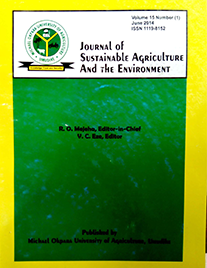Proximate Composition and Organoleptic Evaluation of Bambara Groundnut Pudding (voandzeia subterrenea l. thouars) (okpa) Produced by Different Methods
Main Article Content
Abstract
The study was designed to examine the effect of processing and enrichment on the acceptability and proximate composition of okpa (steamed bambara nut). Dry bambara nut seeds (Voaridzeia subterranean L. Thouras) were soaked, dehulled and wet milled into paste (WMP) using the conventional method, while another portion was dehulled and dry milled into flour (DMF). Both samples were mixed with ingredients and steamed to obtain the enriched okpa (DMFE and WMPE) and these were compared with unenriched okpa samples (DMFU and WMPU). The resultant flour, paste and cooked samples were subjected to sensory and proximate analysis using standard procedures. Result showed that WMP had significantly higher (P<0.05) moisture content and fat content (10.7±0.03% and 6.40±0.03%) than DMF (9.30±0.09% and 5.42±0.00%), respectively. Protein (14.32±0.05% and 12.76±0.00%), carbohydrate (13.69±0.04% and 17.18±0.23%) and fat (6.29±0.00% and 6.20±0.01%) content were significantly higher (p<0.05) in enriched okpa samples (DMFE and WMPE). Sensory evaluation of the enriched okpa samples showed that they were well accepted by the panelists. Addition of other ingredients significantly improved the nutrient content of the conventional okpa.
(Keywords: Okpa, enrichment, processing, proximate, acceptability)
Article Details
References
Alobo, A. P. (1999). Production and organoleptic assessment of Akara from Bambara groundnut (Voandzeia subterranean L.Thouars). Plant Foods for Human Nutrition 53:313-320
AOAC, Official Methods of Analysis.(2005). Association of Official Analytical Chemists, 18th Edn., Washington D.C-USA.
Berchie, J,N., Adu-Dapaah, H.K., Dankyi, A.A., Plahar, W.A., Nelson-Quartey, F., Haleegoah, J., Asafu-Agyei, J.N. and Addo, J.K. (2010). Practices and constrainsts in bambara gound nut production, marketing and consumption in the Brong Ahafo and upper-east regions of Ghana. Journal of Agronomy 9(3):111-118.
Enwere, N.J. (1998). Foods of plants origin: Processing and utilization with recipes and Technology profiles. Afro-orbis Publishers, Nsukka, Nigeria. p59-61.
Iwe, M.O. (2007). Current trends in sensory evaluation of foods. Rojoint Communication Services Ltd, Enugu. Pp 46-47.
Joshi, S.A. (2002). Nutrition and Dietetics, 2nd edition. McGrawHill Publishers, New Delhi.
National Research Council (NRC) (2006). "Bambara Bean". Lost Crops of Africa: Volume II: Vegetables. Lost Crops of Africa. In National Academies Press. ISBN 978-0-309-10333-6. http://books.nap.edu/ openbook.php?record_id=11763&page=53. Re- trieved 2008-07-15.
Olapade, A. A., Ozumba A.U., Solomon, H.M., Olatunji, O. and Adelaja S.O. (2005). Rheological properties and consumer acceptance of moin-moin pre- mix. Nigerian Food Journal. 23:144-147
Okeke, E. C. and Eze, C. (2006). Nutrient composition and nutritive cost of Igbo traditional foods and recipes commonly eaten in Nsukka. Journal of Agriculture, Food, Environment and Extension. 5(1):36-44.
Oresanya, M.O., Oguntade, A.O, Koleoso, O.A. and Odunfa, S.A. (1999). Production of a baby weaning food from maize and cowpea. Nigerian Journal of Nutritional Science 20 (192):48-51.
Oyeleke, G.O., Afolabi, O. and Isola, A.D. (2012). Some quality characteristics and carbohydrate fractions of Bambara Groundnut (Vigna subterranea L.) Seed Flour. IOSR Journal of Applied Chemistry. 2(4):16-19.

